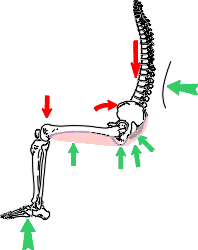
The seat has to:
- keep the correct curvature in the spine
- stop the pelvis tilting backwards
- minimise pressure under the coccyx (tail) and buttocks
- manage high pressure under the pelvis (ischial tuberosities)
- limit pressure under the hamstring muscles
- provide good support under the pelvis and feet
SEAT DESIGN
The working-place drive must be designed for different size of human. There are 3 ways to test whether the design of the seat is ergonomic which is :
NO, it’s not a car of the future, nor the past either. The strange-looking contraption in which the young woman seems to be going for a drive is designed to gather information for engineers. Installed at the University of Michigan, at Ann Arbor, where thousands of persons have sat in it, the apparatus was built for a cushion manufacturer who hopes from countless measurements made on it to obtain an average-size automobile-seat cushion that will be comfortable for the majority of motorists. This method was used since 1940.



No comments:
Post a Comment